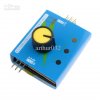Hello guys! I'm trying to build kind of a motorized small skate that moves front/back, with high precision movements (the speed should remain the exactly the same if not changed) and a speed controller.
Basically, it would need to be able to carry 4-5 kilograms on an horizontal surface, with a constant speed (that could be changed using a wired controller).
A friend recommended me to use a servo for the "high precision constant speed", but I don't know how to control a servo or how to make a speed controller for it. Also, I'm not sure if a servo can move a skate with 4-5 kilograms on top of it.
So, basically, I'd need to build a servo controller with on/off switch, invert direction switch and a speed "switch".
BTW, I'd really love if I could build that without any programming, since I don't have any hardware to write to chipsets.
I know I'm asking a lot of things, but it would be really awesome if you guys could help me with this project.
Thank you very much!
Basically, it would need to be able to carry 4-5 kilograms on an horizontal surface, with a constant speed (that could be changed using a wired controller).
A friend recommended me to use a servo for the "high precision constant speed", but I don't know how to control a servo or how to make a speed controller for it. Also, I'm not sure if a servo can move a skate with 4-5 kilograms on top of it.
So, basically, I'd need to build a servo controller with on/off switch, invert direction switch and a speed "switch".
BTW, I'd really love if I could build that without any programming, since I don't have any hardware to write to chipsets.
I know I'm asking a lot of things, but it would be really awesome if you guys could help me with this project.
Thank you very much!
Last edited:


